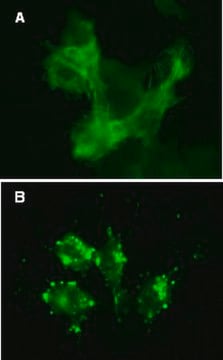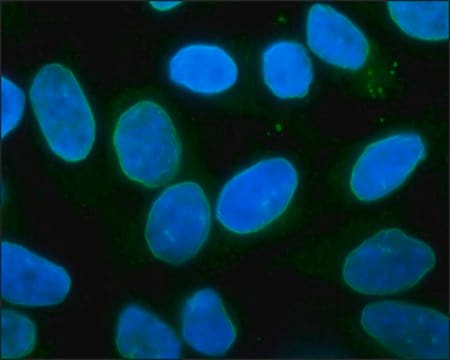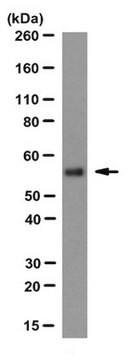06-1002
Anti-LAP2 Antibody
from rabbit, purified by affinity chromatography
Sinonimo/i:
LEM domain containing 4, TP alpha, TP beta/gamma, TPRP isoform alpha, TPRP isoforms beta/gamma, Thymopoietin isoform alpha, Thymopoietin, isoforms beta/gamma, Thymopoietin-related peptide isoform alpha, Thymopoietin-related peptide isoforms beta/gamma, l
About This Item
Prodotti consigliati
Origine biologica
rabbit
Livello qualitativo
Forma dell’anticorpo
affinity isolated antibody
Tipo di anticorpo
primary antibodies
Clone
polyclonal
Purificato mediante
affinity chromatography
Reattività contro le specie
rat, human, mouse, canine
tecniche
immunocytochemistry: suitable
immunofluorescence: suitable
western blot: suitable
N° accesso NCBI
N° accesso UniProt
Condizioni di spedizione
wet ice
modifica post-traduzionali bersaglio
unmodified
Informazioni sul gene
human ... TMPO(7112)
Descrizione generale
The best characterized isoforms of lamin binding protein LAP2 are LAP2α and LAP2β. LAP2β is a type II membrane protein in the inner nuclear membrane that binds lamin B and is important to cell viability and controlling nuclear lamina growth. LAP2α has been characterized as a nucleoplasmic protein that interacts with A-type lamins to control gene expression, transcription, and chromatin organization.
Specificità
Immunogeno
Applicazioni
Representative lot data. This antibody was used to detect the nuclear lamina by immunofluorescence.
Immunocytochemistry:
Representative lot data.
A previous lot was used in confocal fluorescent analysis of A431, HeLa and NIH/3T3 cells using anti-LAP2 rabbit polyclonal antibody (Red).
Actin filaments have been labeled with AlexaFluor 488 -Phalloidin (Green). Nuclear is stained with DAPI (Blue). Positive nuclear staining.
Epigenetics & Nuclear Function
Cytoskeletal Signaling
Qualità
Western Blot Analysis:
A 1:1000-1:3000 dilution of this antibody was used to detect LAP2 in HeLa cell lysate.
Descrizione del bersaglio
Stato fisico
Stoccaggio e stabilità
Risultati analitici
HeLa cell lysate
Esclusione di responsabilità
Not finding the right product?
Try our Motore di ricerca dei prodotti.
Codice della classe di stoccaggio
12 - Non Combustible Liquids
Classe di pericolosità dell'acqua (WGK)
WGK 1
Punto d’infiammabilità (°F)
Not applicable
Punto d’infiammabilità (°C)
Not applicable
Certificati d'analisi (COA)
Cerca il Certificati d'analisi (COA) digitando il numero di lotto/batch corrispondente. I numeri di lotto o di batch sono stampati sull'etichetta dei prodotti dopo la parola ‘Lotto’ o ‘Batch’.
Possiedi già questo prodotto?
I documenti relativi ai prodotti acquistati recentemente sono disponibili nell’Archivio dei documenti.
Il team dei nostri ricercatori vanta grande esperienza in tutte le aree della ricerca quali Life Science, scienza dei materiali, sintesi chimica, cromatografia, discipline analitiche, ecc..
Contatta l'Assistenza Tecnica.








